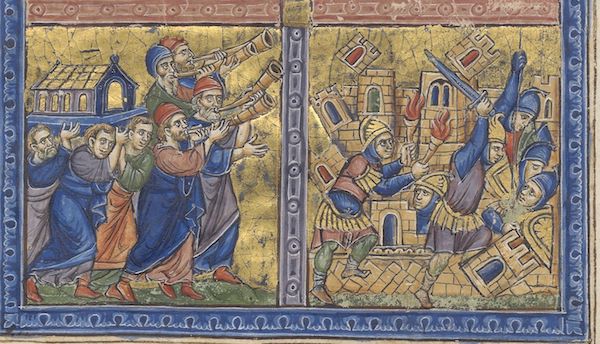We run our website the way we wished the whole internet worked: we provide high quality original content with no ads. We are funded solely by your direct support. Please consider supporting this project.

Reading the Bible “by Faith”
The cruciform approach to reading the Bible—and specifically the culturally-conditioned and sin-stained portraits of God—requires faith on the part of the reader, which I argue in Crucifixion of the Warrior God. On one level we can discern by faith that often times God broke through the limitations and sin of the ancient authors, for we find divine portraits that, to one degree or another, reflect the character of God revealed in Christ. On another level we must discern by faith that God appropriated the limitations and sin of the authors God “breathed” through, for we find divine portraits that, to one degree or another, anticipate the ugliness of the sin-bearing, God-forsaken criminal on the cross. Of course, I am painting with broad brush strokes. In reality, most portraits in the Old Testament are Christ-like to a certain extent and reflect the culturally conditioned and sin-stained humanity of their authors to a certain extent.
To the extent that a divine portrait reflects the character of Christ, it may be regarded as a direct revelation of God’s character. For as with the teachings and actions of Christ, the content of this type of divine portrait directly reflects God’s true, Christ-like character. Conversely, to the extent that a divine portrait conflicts with the character of Christ, it must be regarded as an indirect revelation of God. This calls for a different kind of faith. For as with Christ when he bore our sins and took on the semblance of a guilty, God-forsaken criminal, the content of this type of divine portrait reflects the limitations and sin of God’s covenantal people more than it does his true character.
Along the same lines, as with the sin-bearing Christ on the cross, the indirect revelatory content of this type of divine portrait must be located not at the level of appearances, but in what happened behind these appearances, in what could be called the “meta-dimension” of these appearances. To put the matter in slightly different terms, we only discern the character of God on Calvary when, by faith, we look through the grotesque appearance of this guilty criminal and discern in the depth of this event the unfathomably merciful God stooping to this unthinkable level. We can discern the true character of God in OT divine portraits that look like standard ANE portraits of warrior deities when we, by faith, look through the barbaric appearances to discern the unfathomably merciful God stooping to this unthinkable level.
As such, to the extent that any OT portraits reflects the limited and sinful humanity of God’s people, and insofar as we discern the limited and sinful humanity of God’s people in any other aspect of Scripture, we may discern a harbinger and type of the cross. The same faith that enables us to discern the self-sacrificial God in the depth dimension of the limited and fallen “criminal” who hung on the cross is the faith that enables us to discern the self-sacrificial God in the depth dimension of Scripture’s violent portraits of Yahweh, as well as every other aspect of Scripture that reflects the limited and sinful humanity of its authors. And all of this, I submit, bears witness to the unfailing covenantal love of God.
Image: Bibliothèque de l’Arsenal, Ms-5211 réserve, fol. 69v.
Category: General
Tags: Bible, Cruciform Theology, Faith
Related Reading

What Kind of God Did Jesus Reveal?
The ReKnew Manifesto exists to encourage believers and skeptics alike to re-think things they thought they already knew – hence our name, Re-Knew. I am currently working through the theology of the Manifesto in a series of posts that began a couple of months ago. Over the last few posts, we have been looking at the…

Crucifying Transcendence
The classical view of God’s transcendence in theology is in large borrowed from a major strand within Hellenistic philosophy. In sharp contrast to ancient Israelites, whose conception of God was entirely based on their experience of God acting dynamically and in self-revelatory ways in history, the concept of God at work in ancient Greek philosophy…

Cross-like Love and Non-Violence
Cosmo Spacely via Compfight Though it seems to have been forgotten by many today, the cross wasn’t simply something God did for us. According to the NT, it was also an example God calls us to follow. Hence, after John defined love by pointing us to Jesus’ death on the cross on our behalf, he…

The Cruciform Center Part 2: How John’s Gospel Reveals a Cruciform God
In the previous post, we looked at how the Synoptics illustrate the centrality of the cross. While the Gospel of John varies in its structure and language from the Synoptics, the cross remains at the center. This centrality is expressed in a number of different ways. 1. The role that Jesus’ death plays in glorifying…

Are You Guilty of Marcionism?
Greg responds to the question of whether or not his cruciform hermeneutic is anything like the heresy of Marcion, who basically advocated throwing out the Old Testament. (Spoiler: it’s not.)

Biblical Versus Magical Faith: Reflections on the ReKnew Manifesto
The second core conviction of the “ReKnew Manifesto” is that we believe it is time for the Church to re-think common assumptions about faith. Faith is at the heart of what it means to follow Jesus and to live under the reign of God. Yet Christians rarely seriously reflect on what it means to “have…
